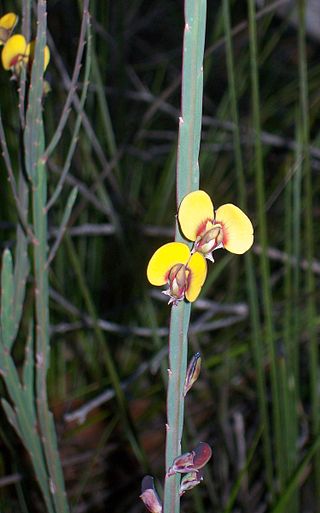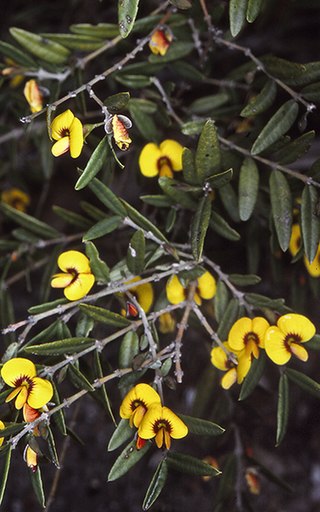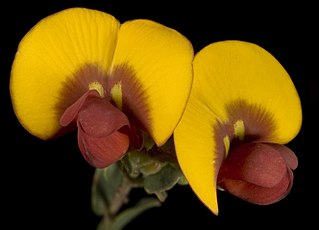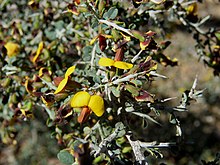
Bossiaea buxifolia, commonly known as matted bossiaea, is a species of flowering plant in the family Fabaceae and is endemic to south-eastern Australia. It is a prostrate to weakly erect shrub with elliptic to egg-shaped or almost round leaves and yellow, red and purplish flowers.

Bossiaea spinosa is a species of flowering plant in the family Fabaceae and is endemic to the south-west of Western Australia. It is a low, dense prostrate or rounded, twiggy shrub with egg-shaped to elliptic leaves and deep yellow to orange and pinkish-red, pea-like flowers.

Bossiaea scolopendria, commonly known as plank plant, is a species of flowering plant in the family Fabaceae and is endemic to New South Wales. It is an erect, sparsely-branched shrub with flattened branches, ending in winged cladodes, the leaves mostly reduced to small scales except on the youngest branches, and yellow and red flowers.

Bossiaea heterophylla, commonly known as variable bossiaea, is a species of flowering plant in the family Fabaceae and is endemic to south-eastern Australia. It is a variable shrub with flattened stems, egg-shaped to linear leaves, and yellow and dark red flowers.

Bossiaea brownii is a species of flowering plant in the family Fabaceae and is endemic to eastern Queensland. It is an erect shrub with egg-shaped leaves and yellow flowers with red markings.

Bossiaea tasmanica is a species of flowering plant in the family Fabaceae and is endemic to Tasmania. It is a prostrate or low-lying shrub with spiny branches, elliptic to egg-shaped with the narrower end towards the base, and yellow and red to pink flowers.
Bossiaea aurantiaca is a species of flowering plant in the family Fabaceae and is endemic to the south-west of Western Australia. It is a rounded or spreading, spiny shrub with oblong to narrow egg-shaped leaves, and golden-yellow and pinkish-red flowers.
Bossiaea barbarae is a species of flowering plant in the family Fabaceae and is endemic to Western Australia. It is an erect, compact, spiny shrub with egg-shaped to elliptic or oblong leaves, and deep yellow and bright red flowers.

Bossiaea carinalis is a species of flowering plant in the family Fabaceae and is endemic to eastern Queensland. It is an erect shrub with narrow egg-shaped to lance-shaped leaves and pink to red and yellow flowers.
Bossiaea dasycarpa is a species of flowering plant in the family Fabaceae and is endemic to a small area in eastern Australia. It is a prostrate or low-lying shrub with narrow oblong to narrow elliptic leaves, and yellow and red flowers.
Bossiaea inundata is a species of flowering plant in the family Fabaceae and is endemic to the Murchison River Gorge in Western Australia. It is a spreading, openly-branched shrub with oblong, elliptic or egg-shaped leaves with the narrower end towards the base, and deep yellow and red flowers.

Bossiaea kiamensis is a species of flowering plant in the family Fabaceae and is endemic to the south coast of New South Wales. It is an erect or prostrate shrub with narrow elliptic or narrow oblong leaves and yellow and red to brown flowers.

Bossiaea neoanglica is a species of flowering plant in the family Fabaceae and is endemic to eastern Australia. It is a prostrate to low-lying shrub with sparsely hairy foliage, egg-shaped to more or less round leaves, and yellow and red flowers.
Bossiaea obovata is a species of flowering plant in the family Fabaceae and is endemic to eastern Australia. It is a small, low-lying or prostrate shrub with egg-shaped leaves with the narrower end towards the base, and pea-shaped, yellow and red flowers.
Bossiaea peninsularis is a species of flowering plant in the family Fabaceae and is endemic to the Eyre Peninsula in South Australia. It is an erect rhizome-forming, more or less leafless shrub with leaves reduced to small scales, and yellow, red and purplish flowers.

Bossiaea pulchella is a species of flowering plant in the family Fabaceae and is endemic to the south-west of Western Australia. It is a slender, erect shrub with egg-shaped leaves, and orange-yellow, purplish brown and dark red flowers.

Bossiaea rufa is a species of flowering plant in the family Fabaceae and is endemic to the south-west of Western Australia. It is a loose, many-branched shrub with elliptic to egg-shaped leaves with the narrower end towards the base, and deep yellow and red flowers.

Bossiaea scortechinii is a species of flowering plant in the family Fabaceae and is endemic to eastern Australia. It is a prostrate to low-lying shrub with simple, elliptic to egg-shaped leaves with the narrower end towards the base, and orange-yellow flowers with red to pinkish markings.
Bossiaea smithiorum is a species of flowering plant in the family Fabaceae and is endemic to the south-west of Western Australia. It is a slender shrub with oblong to cylindrical leaves and orange-yellow and red or purple, pea-like flowers.
Bossiaea spinescens is a species of flowering plant in the family Fabaceae and is endemic to the south-west of Western Australia. It is a slender, spreading or compact, spiny shrub with oblong to oval leaves and yellow and reddish-brown, pea-like flowers.














